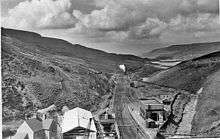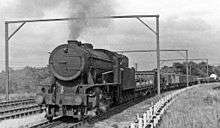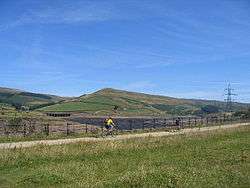Woodhead Line
| Woodhead Line | |
|---|---|
|
| |
| Overview | |
| Type | Main Line |
| System | National Rail Network |
| Status | Partially open |
| Locale | South Yorkshire, Cheshire, Derbyshire and Lancashire |
| Termini |
Sheffield: Rotherwood Sidings / Wath Manchester: London Road (1845–1960) Piccadilly (1960–70) |
| Services | 3 |
| Operation | |
| Opened | 1845 |
| Closed | 1970 (passengers) and 1981 (goods) |
| Technical | |
| Number of tracks | 2 |
| Track gauge | 4 ft 8 1⁄2 in (1,435 mm) |
| Electrification | 1,500 V DC |
The Woodhead Line was a railway line linking Sheffield, Penistone and Manchester in the north of England. A key feature of the route is the passage under the high moorlands of the northern Peak District through the Woodhead Tunnels. The line was electrified in 1953 and closed between Hadfield and Penistone in 1981.
The Manchester to Glossop/Hadfield section is still in operation; east of the Pennines the vicinity of Penistone and the Sheffield to Deepcar section are still open, although the latter is goods-only. The track has been lifted on other sections and much of the trackbed is now part of the Trans-Pennine Trail and National Cycle Route 62. The Woodhead Line has achieved a cult status with collectors of railway memorabilia.
Route
The route from Manchester to Sheffield was 41½ miles with stops at Manchester, Gorton, Guide Bridge, Newton, Godley Junction, Mottram, Glossop and Dinting, Glossop Central, Hadfield, Crowden, Woodhead, Dunford Bridge, Hazlehead Bridge, Penistone, Wortley, Deepcar, Oughtibridge, Wadsley Bridge, Neepsend and Sheffield.[1] Services still run from Manchester to Glossop and Hadfield, and from Sheffield to Penistone continuing onwards to Huddersfield.[2] The section from Deepcar to Sheffield is currently used for goods. The route can be seen on this Google overlay map.
History

Construction

The line opened in 1845. It was built by the Sheffield, Ashton-under-Lyne and Manchester Railway[3] with Joseph Locke as its engineer. In 1847 the railway merged with the Sheffield and Lincolnshire Junction Railway, the Great Grimsby and Sheffield Junction Railway, and the Grimsby Docks Company to form the Manchester, Sheffield and Lincolnshire Railway, which changed its name to the Great Central Railway (GCR) in 1897.[4] Ownership passed to the LNER in 1923 and finally to British Railways Eastern Region in 1948.
The original eastern terminus of the line was at Bridgehouses railway station. By the time of the creation of the Manchester, Sheffield and Lincolnshire Railway in 1847 the railway station at Bridgehouses had been outgrown. A 0.6-mile (1 km) extension including the Wicker Arches viaduct, engineered by John Fowler, was constructed to the new Sheffield Victoria Station, which opened in 1851.
Both goods and passenger traffic was very heavy and some sections of the line were therefore quadrupled.
Electrification

Electrification was first mooted by the Great Central Railway owing to the difficulties of operating heavy steam-hauled coal trains on the Penistone-Wath section (the Worsborough branch), a line with steep gradients and several tunnels. Definitive plans were drawn up by the LNER in 1936; many of the gantries for the catenary (electric wires) were erected before the Second World War.[5]
The Second World War prevented progress on electrification, but the plans were restarted immediately after the war—however this time with plans for a new double-track Woodhead Tunnel. This (third) Woodhead Tunnel was constructed to replace the twin single-bore Victorian tunnels which had been damaged by years of smoke from steam engines.[6] A second Thurgoland Tunnel was also required, as the existing tunnel had inadequate clearance for twin electrified lines.
The Manchester–Sheffield–Wath electrification project was finally completed in 1955 using overhead wires energised at 1,500 volts direct current. Whilst this was tried and tested technology (and is still standard in the Netherlands), the comparatively low voltage meant that a large number of electricity substations and heavy cabling would be required. (It also made regenerative braking by transfer of power from descending to ascending trains in the same section of line comparatively straightforward). The main contractor for the electrification work was Bruce Peebles & Co. Ltd., Edinburgh. Following technological developments (especially in France) 1.5 kV DC was soon superseded by the later network standard of 25 kV AC. This left the Woodhead Line as the only main line in the UK with 1.5 kV DC electrification.
New electric locomotives for the line were constructed at Gorton locomotive works, Manchester. These were the EM1/Class 76 for freight trains (and some passenger duties) and EM2/Class 77 locomotives for express passenger trains. Given the steep gradients on the line, the locomotives were able to use regenerative braking on their descent from Woodhead. Rheostatic braking was also later added. Additionally, Class 506 electric multiple units were built for suburban services between Manchester, Glossop and Hadfield.[7] A new depot at Reddish on the Fallowfield Loop line, was built in 1954 to maintain the new rolling stock.
Closure

Having seen major investment in the 1950s the line was controversially closed to passenger traffic on 5 January 1970[8] when it was clear that the alternative Hope Valley Line through Edale would be required to remain open for social and network reasons and could handle all Manchester–Sheffield passenger traffic. The Class 77 locomotives for passenger traffic were sold to the Netherlands Railways, where 1500 V DC electrification was the standard (and remains so). By the late 1970s, a large part of the remaining freight traffic consisted of coal trains from Yorkshire to Fiddlers Ferry Power Station near Widnes—which required a change to diesel haulage for the final part of the journey.
By the 1980s a combination of alternative available routes, an absence of passenger traffic since 1970, a downturn in coal traffic across the Pennines and a need to eventually upgrade or replace the (non-standard) electrical supply systems and Class 76 locomotives resulted in the line's closure east of Hadfield. The last train operated on 17 July 1981 and the line was mothballed.
The tracks were lifted in the mid-1980s ending short-term hopes of reopening. Almost the entire line east of Hadfield has now been lifted (apart from a few short sections shared with other lines, notably at Penistone). The trackbed between Hadfield and the Woodhead Tunnel has currently been adapted as the Longdendale Trail for hikers and cyclists.
Possible closure of Woodhead 3
In 2007, National Grid, the present owners of all 3 of the tunnels, proposed to move electricity cables from the Victorian to the 1953 tunnel, this work started in 2008 and was completed in 2012. This has meant it is now not possible to use the newer tunnel for railway traffic. In 2007 the Peak District National Park and other relevant local bodies provided many reasons why the tunnel should remain open,[9] but in September 2007 The Government declined to intervene in the matter.[10]
The surviving sections
The suburban passenger service between Manchester, Glossop and Hadfield remains in service, but the electricity supply was converted to standard 25 kV AC overhead in December 1984. The Class 506 EMUs were then withdrawn and replaced by Class 303 EMUs from the Glasgow area. The service is now operated (as of 2013) by Class 323 EMUs.
The Huddersfield line platforms at Penistone railway station remain open, used by the Huddersfield-Sheffield diesel-operated local trains, which traverse the line the short distance between the former Huddersfield Junction and Barnsley Junction.
There is just one other part of the line open to traffic, albeit goods, and that is the single line from Woodburn Junction, on the Sheffield to Lincoln Line, to Deepcar to serve the Corus steel works at Stocksbridge. Currently, there is a single return trip per evening, Monday to Friday, from Aldwarke steelworks in Rotherham to the Stocksbridge site.
Proposals for the future
The Woodhead Line has, unusually for an electric route, managed to achieve a cult status with collectors of railway memorabilia (perhaps because of a feeling that the closure of a modern electric railway was a mistake, given that the alternative routes were (are) not electrified). The original poster of the 'modern' route, published in 1955 by British Railways Board and entitled 'Britain's First All-Electric Main Line', fetches high prices at auction, and is still available in reproduction.
In 1967 it was proposed that parts of the route and the Woodhead Tunnel be used as part of a new Manchester to Sheffield motorway.[11] Only a short section of this motorway within Manchester, now known as the M67 motorway, has been built.
In 1999 Central Railway proposed using the Woodhead tunnel as part of an ambitious scheme to connect Liverpool to London.[12]
In 2002 the Trans-Pennine Rail Group, a broadly based group of County Councils, Unitary Authorities, Passenger Transport Executives (PTE) and the Peak District National Park Authority[13] provided evidence to a transport select committee identified interest from bidders for the Transpennine rail franchise in reopening the Woodhead route.[14] (in 2007 the Transpennine Rail Group was wound up as its work was now being done by the Northern Way and the North West Rail Campaign).[15]
In 2003 the Greater Manchester Branch of the Institute of Logistics and Transport presented evidence to a Parliamentary Select committee mentioning Arriva's interest in opening the Woodhead Line and Tunnel as part of their bid for the Transpennine rail franchise.[16]
In 2006 Translink proposed opening the tunnel and the route for rail freight.[17] This proposal is favoured by some groups opposing the construction of the Longdendale Bypass, a controversial £180m bypass for Mottram in Longdendale, Hollingworth and Tintwistle (which is officially known as the A57/A628 Mottram-in-Longdendale, Hollingworth & Tintwistle Bypass).[18]
There are also plans to restore the route from Deepcar to Sheffield as a Double Tracked heritage line called the Don Valley Railway, to link up with the Sheffield Supertram at Nunnery Junction called "Sheffield Don Valley". Don Valley Railway Ltd, Sheffield City Council and South Yorkshire Passenger Transport Executive are looking at reopening the line to passenger services between Sheffield and Stocksbridge. Stations would be constructed at Stocksbridge, Deepcar, Wharncliffe Side and Oughtibridge with a Sheffield City centre terminus near to the Nunnery Square Supertram stop. The project could cost £4.3 million at a minimum.[19]
On 18 January 2012 during a debate on the proposed Northern Hub (formerly known as the Manchester Rail Hub), Theresa Villiers, the Minister for Rail and Aviation, said "The hon. Member for Penistone and Stocksbridge has again called for the reopening of the Woodhead route. I have to say that was not one that was prioritised as part of the Northern Hub because of the capacity that is still available on the Hope Valley line."[20]
Railworks version
The Woodhead Line is part of Steam software for the train simulation game Railworks.
In popular culture
ITV's Coronation Street character Roy Cropper is building a 00 gauge 1960s-era model layout of the line in the flat above his "Roy's Rolls" Cafe. Although mentioned previously, the layout – as yet incomplete – first featured in episode 8345, first aired on 17 March 2014, when the line's Class 76 and Class 77 locos were mentioned.[21]
See also
- Longdendale: A valley through which the line passes
- Longdendale Bypass: A current road scheme though Longdendale.
- M67 motorway: Details of proposed 1960s motorway scheme that would have used part of the route
- Peak District: The route passes through the national park
- Woodhead Tunnel: A tunnel on the Woodhead line
- TransPennine Express: The current train operator between Manchester and Sheffield
- Hope Valley Line: The route used by the TransPennine Express between Manchester and Sheffield.
- Longdendale Trail: A footpath that follows part of the route of the Woodhead Line
- Don Valley Railway A proposal to open the section from Deepcar to Nunnery Junction, just east of Sheffield city centre
References
- ↑ Bradshaw's July 1922 Railway Guide
- ↑ "Liverpool.pdf" (PDF). Network Rail. Retrieved 26 January 2008.
- ↑ "The Woodhead Route". Railways of Britain. Retrieved 27 January 2008.
- ↑ Awdry, Christopher (1990). Encyclopaedia of British Railway Companies. London: Guild Publishing. p. 133. CN 8983.
- ↑ Johnson, E M (2001). Woodhead, The Electric Railway. Stockport: Foxline. p. 15. ISBN 1-870119-81-9.
- ↑ Johnson, E M (2001). Woodhead, The Electric Railway. Stockport: Foxline. pp. 83–98. ISBN 1-870119-81-9.
- ↑ Johnson, E M (2001). Woodhead, The Electric Railway. Stockport: Foxline. pp. 21–31. ISBN 1-870119-81-9.
- ↑ Nicholson, Christopher (September 2014). "Over the Woodhead in the cab of Tommy". The Railway Magazine. Vol. 160 no. 1,362. pp. 43–47. ISSN 0033-8923.
- ↑ "PDNPA Planning Committee Report, 13 July 2007"
- ↑ "PDNPA Planning Committee Report, 28 September 2007"
- ↑ "HOUSE OF COMMONS Wednesday 23rd June 1976 – M67 (Peak District National Park)". Hansard Prototype. 24 June 1976. Retrieved 25 January 2008.
- ↑ "Lords Hansard text for 10 March 1999 (190310-07)". Parliament. 10 March 1999. Retrieved 26 January 2008.
- ↑ "TRANS-PENNINE RAIL UPGRADE". South Pennines Integrated Transport Strategy. Retrieved 26 January 2008.
- ↑ "Memorandum by Transpennine Rail Group (REN 08)". Parliament. Retrieved 26 January 2008.
- ↑ "TransPennine Rail Group – REPORT OF: STRATEGY DIRECTOR OF GMPTE" (PDF). Greater Manchester Passenger Transport Authority. 17 April 2007. Retrieved 26 January 2007.
- ↑ "Memorandum by the Greater Manchester Branch of the Institute of Logistics and Transport (REN 40)". Parliament. 11 July 2003. Retrieved 25 January 2008.
- ↑ "The Translink Solution". Translink. Retrieved 26 January 2008.
- ↑ "Line Orders, published 8th February 2007 :: Scheme Impacts". Save Swallows Wood. Retrieved 26 January 2008.
- ↑ [Rail Magazine, Issue 650, 11 to 24 August 2010, Page 20] Stocksbridge re-opening feasible? Rail Magazine
- ↑ "Northern Rail Hub debate". They work for you. 12 January 2012. Retrieved 2 April 2012.
- ↑ ITV Player (accessed 17 March 2014)
Further reading
- Jelly, Graham R. (2013). Woodhead: Countdown to Closure. Book Law Publications. ISBN 9781907094156. OCLC 925436442.
- Whitehouse, Alan (2014). The Woodhead Route. Ian Allan. ISBN 9780711037670. OCLC 876287032.
- Hogarth, Peter (November 1988). "Woodhead in the 60s". RAIL. No. 86. EMAP National Publications. pp. 24–29. ISSN 0953-4563. OCLC 49953699.
External links
| Wikimedia Commons has media related to Woodhead Line. |
- The woodheadsite – has good history section
- Route diagram from 1954
- The Don Valley Railway Line
- Another recent (2006) reopening proposal, this time as a 'Rolling Highway' for HGV traffic
- Michael Pead :: Photos of the Woodhead Route
- British Railways in 1960, Woodhead to Manchester
- http://www.eastbank.org.uk/pennine.htm

